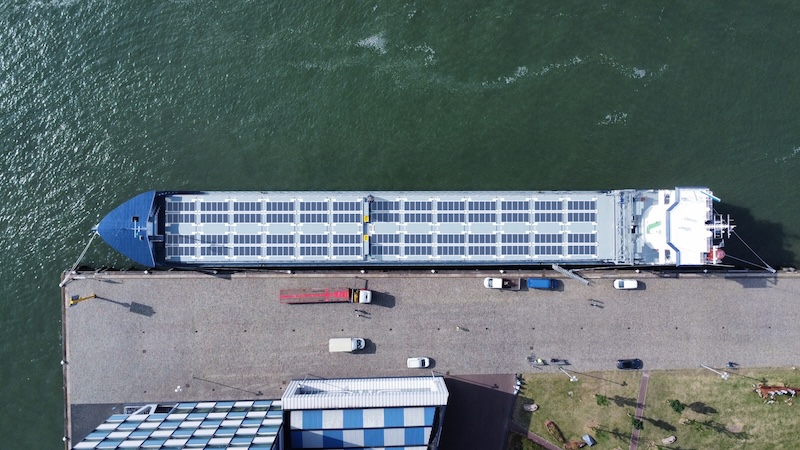Wattlab’s SolarDeck: Ready to Expand into Seagoing Shipping
Wattlab, the Dutch ‘solar power for shipping’ start-up, is not a company that rests on its laurels. After demonstrating impressive growth in the inland shipping sector (including a 312 solar panel-project that has made its way into the Guinness Book of World Records), Wattlab is currently taking its first steps in the seagoing shipping sector. With the first pilot project now complete, it’s time for us to catch up with the company’s founder and CEO Bo Salet to find out more about the results from the pilot project. And to learn more about Wattlab’s ambitions to bring solar power to seagoing shipping with a product called SolarDeck.

Starting in May 2024, Wattlab’s SolarDeck pilot project had two main partners: the Dutch Organisation for Applied Scientific Research TNO and international shipping company Vertom. Furthermore, the pilot has been co-financed by the European Union, or to be precise: by the EU’s Just Transition Fund which is part of the EU’s aims to achieve climate-neutrality by 2050.
“We brought in TNO to focus on the solar power generation of our new product; their aim was to validate whether the power output – and therefore subsequent fuel reduction – was in line with expectations,” begins Bo. “But we also had to validate many other aspects of the SolarDeck. For example, the construction characteristics: taking the salt water and rougher sea states into account, it’s obvious that seagoing ships operate in a tougher environment than inland shipping vessels. For this second validation aspect, we were able to use Vertom’s 7,280dwt general purpose dry cargo vessel Anette, on which we installed one SolarDeck module.”
Let’s not wait any longer… what are the results of Wattlab’s SolarDeck pilot project?
“We recently heard back from TNO that the SolarDeck’s power output is in line with expectations. This positive evaluation is very good. This is partially due to the design; salt water can drain freely from the solar panels; this means that there is no salt crust build-up from evaporated salt water that lowers the power output. And, in terms of the structural integrity of the system, we are happy to report a success. There are some parts of the design that need fine-tuning but there are absolutely no red flags whatsoever. The Anette saw some tough storms during the pilot project, which the SolarDeck dealt with without any damage. What’s more – from a durability viewpoint – we designed this system in such a way that, if there are damages or breakages, then these can be easily repaired by the ship’s crew at minimal cost,” Bo answers. “In addition, we are happy to be able to report many other positive results from this pilot project.”
Safety first
From a safety perspective, SolarDeck performed well. “This system is a stand-alone solar power generator that uses a similar power conversion configuration to our inland shipping product. It is, therefore, inherently safe to use. For example, in the event of cable damage or breakage, the system shuts down automatically; there will never be a current on a broken cable.”
Solar panels are not renowned for their strength. As such, looking at the photos of the SolarDeck installed on Vertom’s Anette, you would be forgiven for wondering if the presence of a wafer-thin solar panel would impact the day-to-day operations of a typical ship’s crew. “We specifically asked the Anette’s crew to carry on their usual deck cleaning activities,” he notes. “This involved rinsing with fresh water, cleaning with normal soap, and also with their toughest cleaning material: heavy duty acidic descaling liquid. The SolarDeck continued working at all times.”
What’s next for SolarDeck?
Now that the SolarDeck pilot project has been completed with undoubtedly successful results, Wattlab has its sights set on bigger targets (or rather, larger surface areas). “We are moving towards full scale; this will be a vessel with the entire deck covered with SolarDeck panels. We will be delivering this before the summer, also in collaboration with Vertom Shipping: a partnership that we are very pleased with,” Bo says.
The deck of a seagoing cargo ship covered with solar panels will definitely be a sight worth seeing. But what about the ship’s loading and unloading operations? Won’t the SolarDeck get in the way? And what about monitoring and managing (surplus) power supply? Won’t that demand a time investment from the crew? “During normal loading and unloading, the SolarDeck can stay in place because it’s thin enough that it fits between two stacked hatches. The only action needed is to disconnect the cables, which needs a minimal amount of time: two minutes of work per edge,” he answers. “And let’s say that the shipowner has a job that involves a deck load: offshore wind blades, for instance. We designed the SolarDeck based on standard 20-foot container twist lock fittings. They are light enough to be carried and the crew can stack all of them within the volume of one 20-foot container.”
“And to answer the question of power output management, the crew doesn’t have to actively think about this; it will be automatic. The generators will turn off when they're not needed. And in the event of a surplus of solar power, the panels will automatically shut down so the they will never overload the system.”
Let’s talk business
Bo wraps up our conversation with a look at probably the most important aspects of owning a seagoing cargo vessel: the regulations and the return on investment. “Based on the results of the pilot project, we predict a fuel reduction of 30 MT with a corresponding 96 MT drop in CO2 emissions. Looking at a shipowner’s EXI and CII scores, this is significant. Moreover, the lower fuel consumption will save shipowners money via the Fuel EU Maritime and EU ETS regulations. And regarding the business case we predict an ROI of around four to five years, not taking any possible subsidies into account. And there is another thing to consider: in general, the older the vessel is, the more inefficient its generators are. Therefore, the business case for installing deck-mounted solar panels is even better with older vessels. And because they are ‘plug-and-play’, they are not a permanent installation: you can simply lift them off the older vessel and put them on the next one,” Bo concludes.
Wattlab | https://wattlab.nl/









.png?r=2381)

